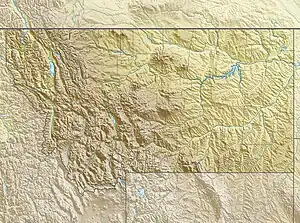| Goat Mountain | |
|---|---|
 South aspect seen from Sun Point | |
| Highest point | |
| Elevation | 8,831 ft (2,692 m)[1] NAVD 88 |
| Prominence | 1,066 ft (325 m)[1] |
| Coordinates | 48°42′16″N 113°35′30″W / 48.70444°N 113.59167°W[2] |
| Geography | |
 Goat Mountain Location in Montana  Goat Mountain Location in the United States | |
| Location | Glacier County, Montana, U.S. |
| Parent range | Lewis Range |
| Topo map | USGS Rising Sun |
| Climbing | |
| First ascent | Unknown |
| Easiest route | Scramble |
Goat Mountain (8,831 ft (2,692 m)) is located in the Lewis Range, Glacier National Park in the U.S. state of Montana.[3] Goat Mountain rises above Otokomi Lake and Goat Lake in the east central section of Glacier National Park.[4]
Climate
Based on the Köppen climate classification, it is located in an alpine subarctic climate zone with long, cold, snowy winters, and cool to warm summers.[5] Temperatures can drop below −10 °F with wind chill factors below −30 °F. Precipitation runoff from the mountain drains into Saint Mary Lake, thence the St. Mary River.
.jpg.webp)
Geology
.jpg.webp)
Like other mountains in Glacier National Park, it is composed of sedimentary rock laid down during the Precambrian to Jurassic periods. Formed in shallow seas, this sedimentary rock was initially uplifted beginning 170 million years ago when the Lewis Overthrust fault pushed an enormous slab of precambrian rocks 3 mi (4.8 km) thick, 50 miles (80 km) wide and 160 miles (260 km) long over younger rock of the cretaceous period.[6]

See also
References
- 1 2 "Goat Mountain, Montana". Peakbagger.com. Retrieved June 12, 2018.
- ↑ "Goat Mountain". Geographic Names Information System. United States Geological Survey, United States Department of the Interior. Retrieved June 12, 2018.
- ↑ Rising Sun, MT (Map). TopoQwest (United States Geological Survey Maps). Retrieved June 12, 2018.
- ↑ "Goat Mountain". SummitPost.org. Retrieved June 12, 2018.
- ↑ Peel, M. C.; Finlayson, B. L.; McMahon, T. A. (2007). "Updated world map of the Köppen−Geiger climate classification". Hydrol. Earth Syst. Sci. 11 (5): 1633–1644. Bibcode:2007HESS...11.1633P. doi:10.5194/hess-11-1633-2007. ISSN 1027-5606. S2CID 9654551.
- ↑ Gadd, Ben (2008). "Geology of the Rocky Mountains and Columbias".
{{cite journal}}: Cite journal requires|journal=(help)